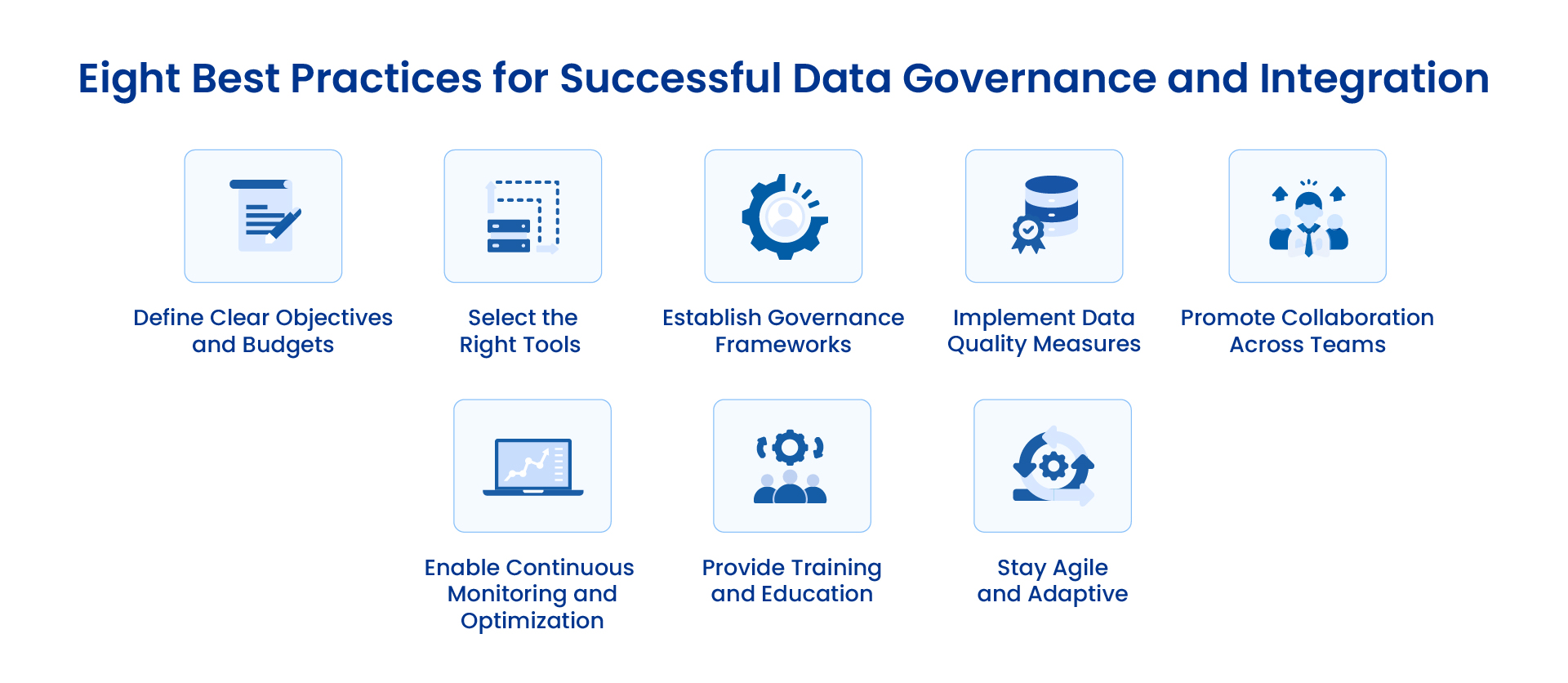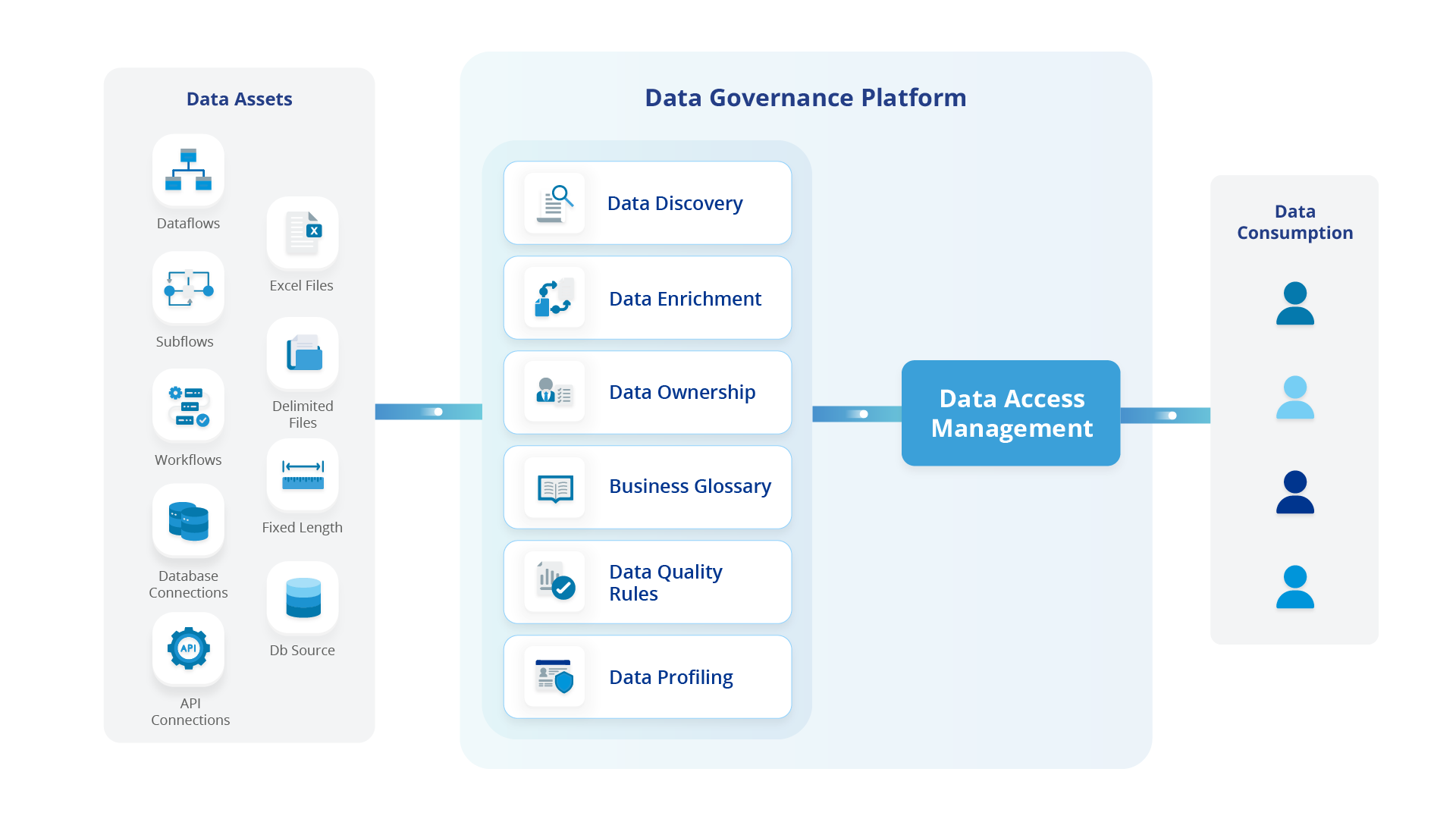
Astera’s Guide to Marketing Data Integration and Governance
Customer data provides a treasure trove of insights into their behavior and preferences. Marketers must leverage this information to drive strategic decisions and optimize marketing campaigns. Analysts must consolidate fragmented data across various systems to use customer data effectively. With proper data integration and governance, marketers can effectively transform their data assets into insights that inform their decision-making.
Importance of Data Integration and Governance for Marketers
Marketing data comes in from diverse sources — CRMs, email marketing software, and analytics solutions – to name a few. Each data source offers valuable insights into customer behavior, preferences, campaign performance, and market trends. Turning this disparate data into a cohesive and actionable strategy by consolidating it into a single unified view allows marketers to:
- Personalize online shopping experiences to improve customer satisfaction.
- Perform optimizations to enhance campaign targeting and effectiveness.
- Identify market trends for strategic planning.
Data Integration Tools
Dedicated integration software is the key to breaking down data silos. Data integration tools and processes combine the scattered data by connecting to the raw data sources. They allow marketing teams to set up automated data pipelines to stream data in real-time.
These pipelines require connectors for each source. For example, there should be a dedicated connector for HubSpot and a separate connector for a database, such as MongoDB or SQL Server.
Integration solutions offer a unified view of customer interactions, preferences, and engagement across channels by combining information from various sources.
Secure Sharing Through Data Governance
Team members often have different understandings of certain terms leading to confusion between teams and departments. Furthermore, the marketing department should also tag and compile important assets and clearly define them to facilitate easier understanding.
Data governance helps marketers consolidate and secure information by creating a central base of data assets that allows different teams to access assets in a single location, streamlining data sharing and reducing confusion.
The benefits extend beyond the confines of the marketing department. Sharing data with other key stakeholders, such as sales and analytics teams, is essential for collaborative decision-making and strategic alignment.
Sales teams use marketing data to identify and score leads and pitches. Marketers enable sales teams to engage prospects with relevance and resonance by providing access to unified customer profiles and campaign metrics. This collaboration helps marketers to close more deals potentially.
Similarly, analytics teams leverage integrated data to derive actionable insights, uncover patterns, and forecast future trends. Collaborating with marketing counterparts enriches data analysis with contextual information, fueling data-driven strategies and continuous improvement initiatives.
In short, streamlined data access and understanding helps the entire organization become more productive and profitable.
Five Benefits of Using a Data Integration and Governance Tool

Data integration and governance tools are an excellent approach to data consolidation and governance due to their ease of adoption and support. The implementation of a data integration and governance tool brings five benefits to marketing teams:
- Improved Decision-Making: With access to reliable, unified data, marketing professionals can make more informed decisions regarding campaign targeting, messaging, and resource allocation. Integration tools provide this data in real time and automatically.
- Increased Efficiency: By automating data integration processes and streamlining data governance tasks, the marketing team can save time and resources.
- Improved Communication: The solution improves collaboration by ensuring that all relevant data assets are in a central location accessible by all. Now, the marketing department can share important information with other departments safely. Compared to sharing individual files and assets, a centralized repository saves hours.
- Better Customer Insights: With a comprehensive view of customer data, including demographics, behavior, and preferences, the marketing team can better tailor their campaigns for their target audience.
- Competitive Advantage: The marketing team can gain a competitive edge in the market with cost and time savings by leveraging automation through these tools, potentially driving increased customer engagement, loyalty, and revenue.
Eight Best Practices for Successful Integration and Governance in Marketing

- Define Clear Objectives and Budgets: Begin by articulating specific objectives and goals for the company’s integration and governance initiatives, such as improving data accuracy, enhancing campaign targeting, or ensuring regulatory compliance. Answer questions like these: Why is data integration needed? What would be better: an in-house tool or an off-the-shelf tool?
- Select the Right Tools: Invest in robust data integration tools that seamlessly combine scattered data sources. Look for solutions with a no-code interface, scalability, flexibility, and compatibility with your existing data sources. Likewise, choose governance tools with features like data lineage tracking, access controls, and audit capabilities to enforce compliance and accountability.
- Establish Governance Frameworks: Develop comprehensive frameworks outlining policies, procedures, and responsibilities governing data management practices. Define data ownership, access controls, and privacy protocols to ensure data integrity and mitigate data breaches or regulatory non-compliance risks.
- Implement Data Quality Measures: Prioritize data quality. Some tools, like Astera, have built-in data validation, cleansing, and enrichment features. Monitor data health metrics regularly and address inconsistencies quickly.
- Promote Collaboration Across Teams: Create a strong collaborative culture and cross-functional alignment within your organization. Encourage marketing teams to collaborate with creatives, data analytics, and sales departments to ensure alignment of objectives and streamline sales opportunities.
- Enable Continuous Monitoring and Optimization: Regularly monitor and optimize integration and governance processes. Use analytics tools and metrics to identify improvement areas and iterate strategies accordingly.
- Provide Training and Education: Invest in training programs to equip marketing teams with the skills to effectively use data integration and governance tools. Educate employees on data governance best practices, regulatory requirements, and the importance of data-driven decision-making.
- Stay Agile and Adaptive: Embrace agility and adaptability in the company’s data integration and governance approach. Continuously evaluate emerging technologies, market trends, and regulatory changes to stay competitive.
An Introduction to Astera’s Solution

Marketing teams require a robust infrastructure seamlessly integrating disparate data sources while upholding stringent data governance standards. They need a strategy to consolidate scattered data into a single repository and safeguard it.
One approach to achieve this objective is by working with data solutions providers. Said providers provide a technological solution and a comprehensive and future-proof data integration and governance strategy.
They also remove the need for costly self-setup and execution of data processes. Data solutions providers enable non-technical users to manage their data quickly, accelerating time-to-insight.
Astera’s leading solutions provider, offers a comprehensive suite of tools and professional services to streamline data integration processes and fortify governance frameworks for marketers.
Seamless, no-code data Integration
At the core of Astera’s offering lies its strong competency in seamless data integration. It empowers marketers to build and automate data pipelines without writing any code.
It empowers marketers with a no-code, drag-and-drop interface. The intuitive UI streamlines data management workflows and enhances user productivity. With its user-friendly design and intuitive navigation, non-technical users can easily move data and gather insights.
Astera provides a wealth of native connectors tailored to diverse marketing data sources, from CRM systems and ERP platforms like HubSpot to cloud-based applications and beyond. With its custom API connectors, it empowers them to effortlessly bridge data silos, facilitating the smooth flow of information across the entire marketing department.
Astera’s integration capabilities allow teams to achieve a unified view of data, breaking down silos and enabling holistic insights into customer behavior, operational efficiency, and market dynamics.
Extensive Data Validation
Astera’s platform incorporates advanced data quality checks and validation mechanisms to ensure accurate, complete, and consistent customer information. From data profiling and cleansing to deduplication and enrichment, Astera equips organizations with the tools to maintain high-quality data.
Robust Governance
Astera’s Data Governance platform provides robust governance, offering features to centralize data assets and enforce compliance standards. Through centralized data repositories and granular access controls, Astera empowers teams to safeguard sensitive customer information, mitigate risks, and ensure regulatory adherence.
Astera’s governance capabilities extend beyond mere data protection—they enable marketers to create a culture of accountability and transparency. With data validation and policy enforcement mechanisms, Astera empowers marketing teams to navigate their data confidently.
Practical Use Case
Let’s look at an example use case to show how data integration and governance can help improve data quality and customer engagement. An Online Clothing Store sells trendy streetwear for young adults. It wants to improve its data management efforts to create targeted campaigns and enhanced buyer personas. The Online Store faces 3 primary data integration and governance challenges:
- Data Silos: Customer data, like purchase behavior and demographics, is scattered across various platforms and tools, such as CRM systems, email marketing software, social media platforms, and analytics tools. Combining this data can lead to higher-quality decisions and improve accessibility for the entire marketing department.
- Inconsistent Data Quality: Without governance measures, data quality is inconsistent across various sources, which can affect the accuracy of future campaigns.
- Data sharing Concerns: The marketing team wants to share relevant data with other functional teams in an efficient way. It needs to implement custom access controls. Also, with the increasing focus on data privacy, the marketing team must ensure data security while coordinating with other departments.
The team wants to consolidate customer information to make analysis and internal collaboration easier than before. Implementing a data integration and governance solution can address these situations in the following ways:
- Unified Data View: The marketing team can gain a unified view of customer interactions and campaign performance by integrating data from various sources into a centralized platform. This holistic view enables better decision-making and more targeted marketing strategies.
- Data Quality Management: The solution can include data quality management features such as data cleansing, deduplication, and validation. By ensuring accurate data across all systems, the marketing team can improve the effectiveness of their campaigns and customer communications.
- Data Sharing and Custom Controls: With built-in governance mechanisms, the solution can enforce access controls to ensure the correct data is available to the right team, helping reduce data breaches and ensuring only essential data gets shared.
The Results of Using Astera:
The team decided to implement Astera’s solution. Using Astera’s data integration and governance software yielded 4 significant positive outcomes:
- Improved Customer Engagement: With a unified data view, the marketing team could more efficiently analyze customer interactions and campaign performance. This holistic understanding empowered them to craft personalized and targeted marketing campaigns that resonated with their audience, improving customer engagement and conversion rates.
- Improved Data Quality: The data quality management features, including data cleansing, deduplication, and validation, ensured the marketing team worked with accurate and consistent data. This improvement reduced errors in marketing campaigns, minimized wasted resources, and enhanced the overall effectiveness of their marketing efforts.
- Streamlined Collaboration: The built-in governance mechanisms facilitated seamless data sharing among various teams, such as sales and analytics, without compromising data security. Custom access controls ensured that sensitive information was protected.
- Enhanced Data Security and Compliance: With Astera’s robust security measures, the marketing team could confidently manage and share data while adhering to privacy regulations. This compliance reduced the risk of data breaches and built trust among customers.
Start Governing Your Data Effectively With Astera
Data integration and governance for marketers unveil many opportunities. Organizations face multiple considerations in their data management strategies, from the need to consolidate incomplete, scattered data to the security of internal data assets and sharing.
Tools like Astera provide comprehensive solutions designed to streamline integration processes, fortify governance frameworks, and unlock data’s transformative power.
To learn more about how Astera can help you consolidate data and create a strong data governance strategy, schedule a personalized demo or contact us now!



